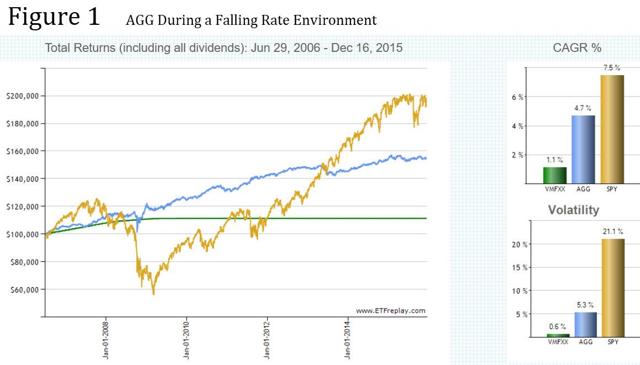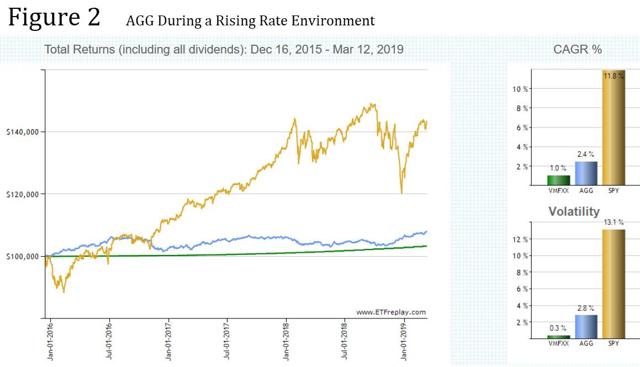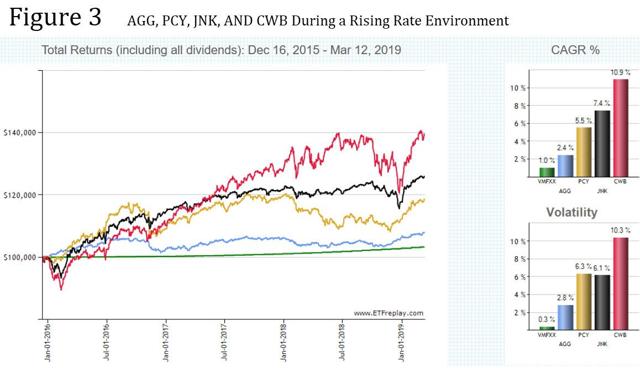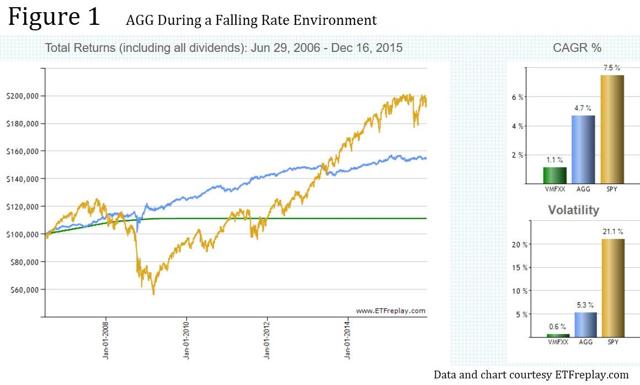[ad_1]
If you’ve been dutifully invested in a bond fund as part of managing risk within your portfolio, you’re likely familiar with AGG, the iShares core U.S. aggregate bond ETF. A one-stop shop for investors looking to hedge a portion of their portfolios with bonds, AGG was designed to track the Bloomberg Barclays U.S. Aggregate Bond Index, an intermediate term, market cap-weighed index representing most U.S. traded investment grade bonds – including Treasuries, government agency, mortgage-backed, corporate, and some foreign bonds. [More details on this Bloomberg Factsheet.]
AGG isn’t alone in trying to replicate the performance of the Bloomberg Barclays Index. Other ETFs with similar objectives include Vanguard’s Total Bond Market ETF (BND), Schwab’s U.S. Aggregate Bond ETF (SCHZ), and SPDR’s Portfolio Aggregate Bond ETF (SPAB) – as well as a few mutual funds. Although they all track tightly, I’ll single out AGG for example purposes as it has a longer lifespan under its belt.
With broadly diversified exposure to the U.S. investment grade bond market, AGG and the others have been popular with investors seeking a modest income and a hedge against equity downdrafts. The beauty part? For years, those benefits have been augmented by a rise in the price of the fund itself, adding wealth to those portfolios it was designed to protect.
Some of those years, in particular 2007 through 2015, coincide with the most accommodative monetary policy in U.S. history. It was a good time to be in Treasury-heavy bonds, with AGG delivering a total return of 54.3% from June 29, 2006 to December 16, 2015. That worked out to a 4.7% compound annual growth rate (OTCPK:CAGR), roughly double that of dividends alone.
But things changed in late 2015, with the Fed approving a quarter-point increase in its target funds rate – nine years after the previous rate hike. And with that, a new era of rising interest rates was upon us.
How would AGG hold up in this rising interest rate environment? We’ve now got a three-year track record to evaluate since that historic Fed move. We’ll get to that in a moment. But first–
A peek at the popular AGG during the accommodative years (2006-2015).

Data and charts: ETFreplay.com
In Figure 1 (above), the dates of the chart provide a bookend for interest rate hikes; June 29, 2006 was the last hike of the key rate (to 5.25%) before the financial crises and the Great Recession, which drove the Federal Open Market Committee (FOMC) to steadily reduce rates, ultimately to zero in 2008. December 16, 2015 marks the next increase in the target funds rate, some seven years later.
Note:
- Green line is the Vanguard money market fund VMFXX, a stand-in for cash.
- Blue line is AGG.
- Gold line is SPY, inserted for comparison.
The compound annual growth rate (OTCPK:CAGR) came in at 4.7% for AGG during this time frame. Dividend yields have fluctuated, but if we assume a 2.5% annual average, that leaves 2.2%, give or take, as annual appreciation in the fund. Not bad given the peace of mind that comes with this worry-free bond fund. That peace of mind is most evident where SPY (the gold line) dips dramatically in the front half of the chart. That would be the crash of equities during the Great Recession. AGG had a sharp spike down in the beginning (it’s largest max drawdown for this timeframe), then powered upward from there, helping to mitigate some of the downside in one’s balanced portfolio.
But, as we’ve noted, things changed on that December 16, 2015 with an historic rate increase after a 9-year hiatus. How has AGG fared since then?
AGG during a rising interest rate environment.

Data and charts: ETFreplay.com
Figure 2 shows the price action of AGG from the first 25 basis points move in interest rate since the Great Recession, until present (date of writing). CAGR has practically been cut in half. Subtracting the average annual yield of 2.5% from the CAGR leaves us with virtually nothing to show for fund appreciation. In effect, for three plus years you’ve made dividends, and nothing more, from an investment in AGG.
Now don’t get me wrong, a two and a half percent dividend is nothing to sneeze at. That beats the overall performance of long-term Treasuries like TLH, the iShares 10-20 Year Treasury Bond ETF, coming in at 1.9% CAGR, as well as all manner of shorter-term Treasuries and money market funds (like VMFXX on the charts). And you’re still providing valuable protection for the portfolio – a key point that we’ll circle back around to in a moment.
But is a 2.4% CAGR in a bond investment as good as it gets in a rising interest rate environment?
Not necessarily. Yes, the common refrain from financial advisors is “in general, bond prices move inversely to interest rates.” But the universe of bonds are made up not just of U.S. Treasuries, which are very interest-rate sensitive and most susceptible to that inverse relationship. But bonds also include municipal bonds, corporate bonds, emerging market bonds, government bonds (domestic and international), high-yield bonds, inflation-protected bonds, and preferred stock/convertible bonds, all of which have varying levels of interest rate sensitivity and therefore varying degrees of adherence to the “inverse” rule of thumb.
Three bond funds that aren’t Treasuries.
Let’s call out three categories of bonds that have less sensitivity to the proclamations of the Fed: emerging market, corporate, and convertible. And representing each, in that order, the following ETFs:
- PCY – tracks an index of US-dollar-denominated sovereign debt in emerging markets.
- JNK – tracks an index of high-yield, U.S. dollar-denominated corporate bonds.
- CWB – tracks an index of U.S. convertible securities.
Let’s see what they look like for the same dates as before, December 16, 2015 to Present (rising rate environment ).

Data and charts: ETFreplay.com
Figure 3 notes:
SPY has been removed to lessen clutter. VMFXX (green line) remains as a stand-in for cash.
- Blue line is AGG.
- Gold line is PCY.
- Black line is JNK.
- Red line is CWB.
At first glance, PCY, JNK, and CWB all appear to be preferable bond choices over AGG in a rising interest rate environment. Now, some portion of those compound annual growth rates are accounted for by dividends (the dividend yield of PCY is currently 4.86%, for JNK it’s 5.85%, and for CWB it’s 2.05%). But still, given that these are bonds, returns seem impressive.
But here’s the rub. High dividend yields, and high returns in general, typically belie a tradeoff with risk.
PCY – Invesco Emerging Markets Sovereign Debt ETF.
In the case of PCY, with equal-weight exposure to the U.S. dollar-denominated sovereign debt of more than 30 different emerging market countries, Federal Reserve actions are largely out of reach – at least directly. Indirectly? Consider adverse currency fluctuations. Because PCY invests in dollar-denominated bonds, a strengthening dollar (often a result of rising U.S. interest rates) becomes a fiscal worry for emerging market states.
And then there’s the ever-present danger of credit risk. According to Investopedia, 52% of the fund’s 84 holdings are rated AA, A or BBB. However, 44% are rated BB, B or the highly speculative CCC rating.
In relatively stable times, defaults of sovereign bonds – though rare – do occur (most recently, Ukraine in 2015 and Argentina in 2014). And should the entire global market tank? History has left us an example of that. In 2008, the fund saw a drawdown of -41.9% when global markets crashed. While not quite as bad as the drop in the S&P 500 index, PCY would have offered little in the way of portfolio protection.
Seeking Alpha author and CFA Dan Victor does an excellent job of detailing the risks and rewards of PCY in his recent article Invesco EM Sovereign Debt ETF: Global Macro Monthly Income. And the website ETF Database further explores the fund with their piece, ETF Spotlight: Emerging Markets Sovereign Debt Portfolio (PCY).
JNK – SPDR Bloomberg Barclays High Yield Bond ETF.
The high-yield JNK has issues with credit risk, as well. While Treasury bonds will never default since the government can tax and the Federal Reserve can print money as it pleases, not so with corporate debt. And JNK is populated with lower-rated corporate debt (over half of the fund is in bonds rated B or CCC – they don’t call them “junk” bonds for nothing). Still, on any given day, a default will not have a material effect on an EFT of this size. The problem arises when key sectors or the economy as a whole begins circling the bowl. Witness 2008: JNK saw a drawdown of -38.6%. Again, so much for portfolio protection.
If interest rates rise gradually and economic growth remains on track we would expect high-yield bonds to outperform, says Chris Kim, chief investment advisor at Tompkins Financial Advisors in Ithaca, New York.
The challenge high-yield investors face is if the [Federal Reserve] raises interest rates too quickly, it could upend economic growth and cause an increase in default risk, recession, etc. –excerpted from Where High-Yield Bonds Can Fit in a Portfolio, U.S. News & World Report.
CWB – SPDR Bloomberg Barclays Convertible Securities ETF.
Finally, CWB, the convertible bond ETF. Convertibles are bonds that the holder can convert into a specified number of shares of common stock in the issuing company, or cash of equal value. While most often issued by companies with low credit ratings, and that poses its own risk, the fact that convertible bonds are hybrid securities with debt- and equity-like features mean they most frequently trade like equities. Translation: they can take it on the chin just like stocks in the event of equity downdrafts.
The inception date for this ETF was April 14, 2009, so I don’t have a 2008 history to report. But you can see in Figure 3 the V-shape crash and recovery in December 2018 – January 2019, basically following the equity market correction.
Seeking Alpha and Morningstar author Timothy Strauts provides a good overview of convertible funds in his article Bond, Convertible Bond – A Secret Agent For Your Equity Allocation?
Another look at those max drawdowns.
Because risk metrics are of paramount importance when using bond funds as a hedge in a portfolio, let’s have another look at the max drawdowns for the bond contenders we’ve just outlined.

Data and charts: ETFreplay.com
Figure 4 demonstrates the problem. The max drawdown of AGG, at -4.5% for the three-plus year timeframe, is bested only by the money market fund VMFXX, coming in at zero. Everything else on the chart would provide a far less stabilizing influence on one’s portfolio. That is, if each was the only bond fund represented in a buy-and-hold portfolio.
Conclusion
Are there bond funds that can weather the storm of rising interest rates? Yes, there are. Treasury funds are most susceptible to, and demonstrate an inverse relationship with, U.S. interest rates. But sovereign debt, high-yield corporate bonds, and convertible bonds, to a lesser extent.
The problem becomes one of risk. If a bond fund is in a portfolio primarily as a hedge, to mitigate negative movements in equities and help us stay disciplined during market turmoil, then returns alone do not tell the whole story.
Earlier I asked, is a 2.4% CAGR in a bond investment as good as it gets in a rising interest rate environment? Let me add a qualifier: is a 2.4% CAGR in a bond investment as good as it gets in a rising interest rate environment – while maintaining the need for low risk and maximum portfolio protection?
Answer: short of a rotational trading strategy, maybe so. If you’re committed to a buy-and-hold playbook, buy AGG (or one of its contemporaries like BND) and hold for the long run. You’ll weather both rising interest rate environments, and falling. And somewhere down the road, you’ll even out and do OK.
And perhaps most importantly, you’ll be providing a protective hedge to the equity portion of your portfolio, keeping you in the game and your hand off the sell button during bouts of volatility and the inevitable corrections and bear markets.
A Bond Rotation Model.
An alternative to buy-and-hold, my bond rotation strategy, Bond Bulls, was developed to take the guesswork out of bond fund investing. With a focus on delivering outperformance[1] while keeping risk metrics in line with AGG (benchmark for the strategy), it’s one of four adaptive asset allocation models that can be found at Trendline Profits.
[1] The Bond Bulls rotation strategy has delivered an 8.4% CAGR for the same three-years-plus timeframe outlined (our Rising Rate Environment) with a -4.0% max drawdown. From 2008 to present, incorporating both falling and rising rate environments, the strategy has delivered a 12.4% CAGR with more favorable risk metrics than AGG. Backtested returns.
Disclosure: I am/we are long JNK, PCY. I wrote this article myself, and it expresses my own opinions. I am not receiving compensation for it (other than from Seeking Alpha). I have no business relationship with any company whose stock is mentioned in this article.
Additional disclosure: I am neither an economist nor an investment advisor, registered or otherwise. The information provided is for educational purposes and should not be considered as advice. No author on the Web, myself included, can or should provide advice on the suitability of any fund, combination of funds, or strategy for inclusion into your personal portfolio. Investors should do their own due diligence and, if in doubt, employ the services of a qualified financial professional.
[ad_2]
Source link Google News

